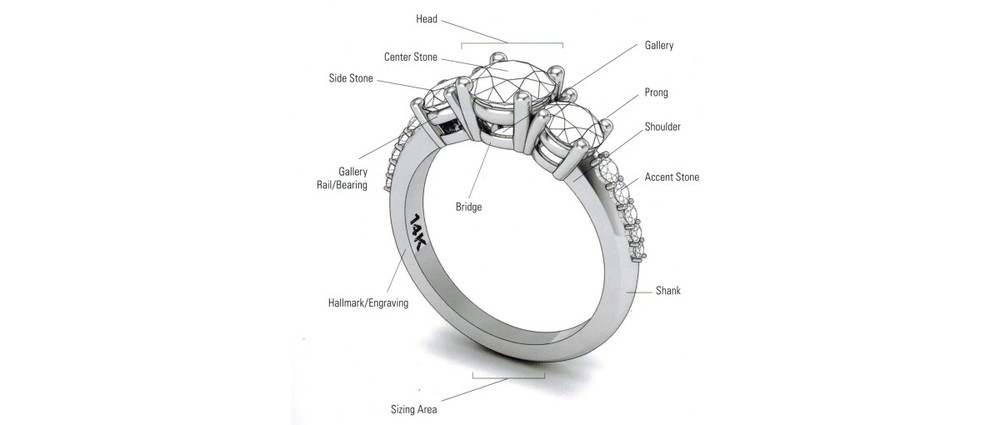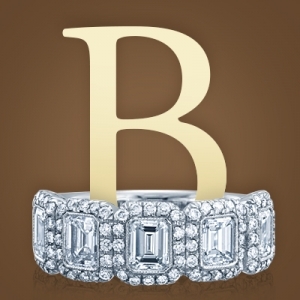
Rings come in different shapes and sizes. From casual to formal, we've seen them all here at Braunschweiger Jewelers. In fact, rings are some of the most common pieces we see for repair in the service department at our jewelry stores.
Sometimes when we try to explain to clients what needs to be repaired on their ring, we're greeted with blank stares. It's not surprising since rings are complex pieces of jewelry with many parts. Because of this complexity, many customers aren't familiar with the verbiage used when talking about rings.
I don’t blame anyone for not knowing the different parts of a ring. Unless you're in a jewelry store or talking to someone in the industry, how often do you need to know what a gallery rail is? However, if you're interested in redesigning a ring, getting a ring fixed, or altering a ring in any way, it’s a great idea to know the terms of the components that make up a ring. This puts you ahead of the game so that you can better understand what the jeweler is talking about, and be better at explaining to that jeweler what you want. Even if you aren’t doing any work to a ring and you just got engaged, inherited a ring, or you just like jewelry, it's great to know the terminology when it comes to the "anatomy" of a ring.
Let’s start slow with a solitaire engagement ring, a ring with one single mounted stone.
Yes, it looks simple, but it still has a few different pieces that make up its whole. The first thing you see is the centerpiece of the ring: the stone. That stone, regardless of its type, is held to the ring somehow. The most popular way to do this is with prongs.
There are many different types of prongs, some of which are called fishtail, split, four/six/multipronged, V-prong, etc., but they all have the same purpose: to keep the stone in the ring.
If you see no prongs, there is a chance the stone is bezel, or even channel set. But regardless, the stone is still being held to the ring.
A gallery rail provides some lateral strength to the prongs. Sometimes diamonds are set into the gallery rail to give the ring’s profile some sparkle.
The head refers to the prongs and gallery rail as a whole. This is a more general term to describe the top of the ring; it encompasses the prongs, gallery rail, and stone(s).
Under the gallery rail and head is the bridge. This one is tricky because not every ring has a bridge, or the bridge is not as clearly cut as it is in the example in the picture. This is where we often run into sizing problems because the bridge falsely makes the ring bigger than it is.
Working our way down the side of the ring, we come to the shoulder. Similar to the anatomy of a torso on a human being, this is not quite the side of the ring (or rib cage), but it’s between the head and side. This is where you might see accent stones, engraving designs, or even tapering.
Next is the shank. A ring wouldn’t be a ring without a shank. And even before a ring becomes a ring, you start off with a blank shank; it’s the base to which all parts of the ring are attached. A shank can come in all different sizes and shapes, but this piece of metal generally is the spine or backbone of the ring.
Finally, the very bottom of the ring in the center of the shank is your sizing area or sizing bar. Lots of rings have special unique designs to their shanks, and this makes sizing extremely tricky for jewelers. If a designer wants customers to be able to wear the beautiful rings they make without special ordering every ring, sizing is almost a requirement. Incorporating a piece at the bottom of the shank that does not carry on that unique design makes it easy to size without losing much of the aesthetics.
Most every ring will be stamped with a metal type. There are many stamps and marks to identify the different types of metals used to make a ring. If it is a piece of fine jewelry and not a costume piece, it most likely has a stamp on the inside of the ring identifying what it is. If there is no stamp, there are a few different ways to determine the ring’s authenticity and value. Stop by one of our locations and a jeweler will be happy to help you.
To learn more about rings, feel free to visit either of our New Jersey jewelry store locations in Morristown or New Providence to learn about and browse our large selection of rings. If you'd like to talk to someone directly about rings, you can contact us online anytime by emailing us directly at info@braunschweiger.com, or simply fill out our contact form. We'll answer your questions quickly.
|
|
Added By: | |

|
Braunschweiger Jewelers Wedding Services Morristown, NJ 07960 US |
| View Profile » Contact » | |
